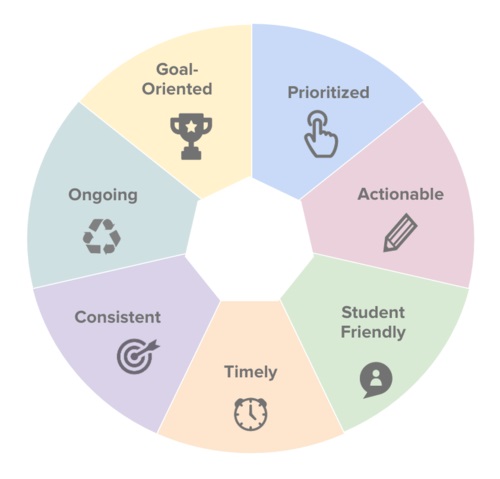How Strong Are Your Feedback Skills?
Pause for a minute to consider the two different pieces of feedback below. Apart from the length, what sets these comments apart? Which piece of feedback is more useful for a budding student writer? Why?
Example No. 1: “You didn’t fully address the prompt in your thesis.”
Example No. 2: “Make sure to tie everything back to your thesis. While your points on the National Bank are good, the example of the Trail of Tears does not seem relevant to your thesis about the common man.”
When comparing the two, here are a few considerations:
- Example 2 directly references the student work so it’s personalized and specific.
- Example 2 pinpoints examples to make the feedback extra clear and actionable.
- By including something the student did well as well as something she needs to work on, example 2 is positively framed and balanced.
- Example 1 is vague. The student probably thought she did address the prompt, so this feedback doesn’t help the student understand her error or the steps she can take to grow and improve.

Considering all this, it’s clear to see that not all feedback is created equally. While example 2 is a much stronger piece of feedback, it can still be improved upon. For instance, why are the points on the National Bank “good”? Good is a fluffy word that doesn’t really tell the student what she did well.
Let’s take a closer look at what makes for truly great feedback and explore some strategies and best practices to ensure your students (and teachers!) always receive the most impactful feedback on their work.
The 7 Hallmarks of Effective Feedback
Providing effective feedback to students is a teachable skill that can be acquired and improved through practice and coaching. It’s vital to strengthen this skill because effective feedback leads to higher test scores in the short term and lower failures, better attendance, and fewer suspensions in the long term. Good feedback supports every other effort in curriculum, assessment, and teaching!
At Marco Learning, we use a standard framework to teach, provide, and evaluate effective feedback. Our framework is adapted from renowned educator Grant Wiggins’ article, “The Seven Keys of Effective Feedback” and is thoughtfully designed to serve as a handy guide for all teachers looking to improve their feedback skills.
To be most effective, written feedback must display these 7 Hallmarks
#1: GOAL-ORIENTED
Feedback on student work should be tied to specific and measurable learning goals, skills, or standards. When giving feedback, it’s important to link your comments to the expectations laid out in the assignment prompt and rubric. That way, you and your students have a clear and mutual understanding of the expectations and a common language to discuss their performance in relation to the expectations.
Directly reference the prompt and rubric components, using similar language when possible. Feedback should serve to help students understand where they are in relation to the stated goals, including what they’re doing well and where they need to keep practicing.
Teacher Tip: To learn more about why and how to effectively use rubric language in your feedback, read our guide where we cover three important topics:
- Using a rubric to remain objective and goal-oriented in your feedback
- Using a rubric to help focus and prioritize your feedback to students
- Using a rubric to help make your comments actionable and ensure students have a roadmap for success
#2: PRIORITIZED
Feedback should be concise and focused on the areas of strength and areas of growth that will have the greatest impact on a student’s writing. It isn’t feasible or advisable to provide feedback on every aspect of a student’s work. That level of feedback would be incredibly overwhelming and demoralizing for even the stronger writers, let alone your struggling kiddos!
Concise, prioritized feedback is more digestible for students and easier to internalize and implement. Whenever you’re reading a piece of writing, you will have to make judgment calls on where to focus your comments. Make your selections with the goal of the essay in mind. What are the most foundational and critical aspects of the writing process that this student needs to continue working on? Kristina Robertson, a veteran educator from Roseville, MN, wrote an article suggesting that teachers “focus on one or two concepts at a time when listening to or reading student work.” You don’t have to cover everything!
Teacher Tip: As a general rule, we recommend focusing on the “big picture concerns” like thesis, organization, evidence, analysis, and development before focusing on the finer points of voice, style, grammar, and conventions. This is always a judgment call, of course, but you don’t want to get hung up on comma splices and typos when half of the class hasn’t addressed the prompt in their thesis!
#3: ACTIONABLE
Feedback should be so specific that your students immediately know how to take action. Your comments should clearly describe their individual successes and shortfalls and directly reference their work in order to point the student to his or her next steps. To advance students’ metacognition and enable them to self-assess their work, ask probing questions that will spark thoughtful reflection and a new understanding of how to develop their work.
It’s imperative that you avoid broad and vague feedback, as this will only lead to student frustration, confusion, and stagnation. Some teachers fall into the trap of making their comments really broad because they think that will be most broadly helpful for the future or allow their student to make bigger, higher-impact changes…but the opposite is often true!
If the task is too big, students won’t know where to start. Even if a student isn’t revising this particular piece of work, specific examples will help them reflect on their work and understand exactly what they did well or exactly what could have been stronger, and how. They’ll have an easier time understanding how to apply your comments to future writing.
Teacher Tip:
- Use quotes and paraphrase from student work to provide illustrative examples when you can. In-line comments are great for this!
- Ask specific probing questions and include narrative comments to get the student thinking in the right direction. This is a particularly effective tool for helping students develop their analysis. Why did you include this quote? What does it tell us about the author’s motivation?? You lost me here… how does this tie back to your main argument? I’d love to hear more from you on this point! How could you take your analysis further to really drive your argument home?
- Keep your feedback balanced. Make your positive feedback (“glows” or areas of strength) just as specific as your constructive feedback (“grows” or areas for growth). This will help students see exactly what they’ve done well, repeat good habits in the future, and feel motivated to keep writing!
- Assume that students are doing their best! If they didn’t do something, it’s likely because they didn’t know how to do it well. Feedback that just restates assignment expectations isn’t as helpful as feedback that digs into the HOW and WHY.

When giving feedback, think of yourself as a guide or coach, not an editor. Your job isn’t to correct your student’s writing; your job is to help guide and support your student on their path to becoming a more confident, competent writer. When reading your feedback, students should immediately know their next step for improvement!
#4 STUDENT-FRIENDLY
Feedback should be personalized and engaging to ensure it reaches the student. To aid student acceptance of feedback, respond like a reader who is seeking to understand what the student has written. An encouraging, positive tone will go far in helping students accept your feedback and apply it to future work. Be sure to use language that is clear and not too technical so that students can understand and internalize the feedback on their own.
Teacher Tip: Accommodate your feedback! Students with disabilities, diverse learners, and English Language Learners may be reading and writing at a different level than their peers. Keep this in mind when you are composing your feedback and always consider your sentence structure, word choice, vocabulary, and length of feedback. It is important that your feedback is accessible to every student so they can independently apply it on future assignments. For more on giving English Language Learners effective feedback, read our post on supporting ELLs here.
Keep in mind that students with disabilities are often the students who will benefit most from high-quality feedback when it is ongoing, consistent, and timely. Even more so than general education students, these students need to be made aware of what specific goals they should be working on and how they can master them, within their own capabilities. John O’Connor, a special education teacher and director with 30 years of experience, emphasizes that students with disabilities “need more Practice Turns and Feedback to master the same skills” but “typically get the least.”
Students with IEPs and English Language Learners do not always receive the personalized attention that they need in general education classrooms, which can cause them to have a negative view of their school experience. This is where you come in! Providing these students with highlights of what they are doing well, as well as personalized and meaningful next-steps for them to take in order to increase their learning, has the potential to motivate students to continue working in an environment that may be new or different to them.

#5, 6, AND 7: ONGOING, CONSISTENT AND TIMELY
These three hallmarks go hand in hand. To be most effective, feedback must be ongoing, consistent, and timely. This means that students need ample opportunities to use feedback and that feedback must be accurate, trustworthy, and stable. When feedback isn’t timely, students are disengaged and demotivated. As a teacher, your job is to build in regular feedback loops into your practice so that students get effective feedback throughout the year.
Teacher Tip: To be consistent, it is important to use consistent rubrics! While writing goals will vary from one prompt to the next and writing expectations will grow each year, you and your department can still use a consistent scoring framework, employ consistent language, and set clear and consistent expectations for your students around common writing goals.

If you aren’t already using common rubrics as a department, I’d encourage you to visit our FREE teacher site, RubricCreator.com, to access our bank of standards-aligned rubrics, called PODS. PODS are built around 4 key writing components – Purpose, Organization, Development, and Style. We’ve created a number of different rubrics for various writing prompts based around this common PODS framework. You can use the PODS rubrics as is or edit them to meet your needs. RubricCreator.com makes it easy to share, edit, print, and create new rubrics from scratch.
Putting Pen to Paper
Effectively responding to student writing has never been more important. Writing is a foundational skill, critical for success in today’s increasingly digital world. And just like any other skill, becoming a confident, competent writer requires ample amounts of practice and feedback.
The next time you give your students a writing assignment, I highly encourage you to practice your effective feedback skills. To check that a piece of feedback you are giving is effective, simply use the acronym GPAS (Goal-oriented, Prioritized, Actionable, and Student Friendly). These are four of the 7 hallmarks that apply to single pieces of feedback; ongoing, consistent, and timely feedback are bigger picture and more about your feedback process.
You can use our handy checklist to ensure that your feedback is goal-oriented, prioritized, actionable, and student-friendly. Trust us, your students will thank you for it!

 Help
Help